Graphic design is the backbone of digital communication, marketing, and branding. The international market of graphic design is anticipated to exceed the margin of $249.5B by 2026 if a 7.5% compound annual growth rate is achieved, as per a report by Grand View Research.
Whether they are a matter of news, a website, or an advertisement, graphic design tools are needed so that the designers can come up with the exact model of them.
In the year 2025, there are a plethora of witty tools for graphic design which have been launched for newbies as well as those who master the skills.
Some tools require a paid plan to unlock premium features.
This article focuses on 15 top free and paid graphic design tools that will inevitably feature their respective technology, the good and the bad things, and the most suitable end-users for them.
If the right tool is present, then it can miraculously unfold all the ideas of your mind, and thus you can achieve great success in a world that is rapidly gaining a foothold.
Role of Graphic Design in Today’s World
Graphic design tools are now indispensable in branding, marketing, and communication. They aid in delivering the necessary information design-wise to the clients, thereby improving user experience and strengthening the brand identity.
Graphic design tools set the pace for every digital and paper medium, from social media to website design.
Developments in AI and digital technologies have also been evident, with designers using hassle-free features that make them more efficient.
Graphic design is a very crucial activity in the area of digital marketing, branding, and content creation.
Regardless of whether you are a professional designer or a novice, the right graphic design tools can set you apart.
In the year 2025, there are several free and usable graphic design tools available on the internet, and new ones are developed each day.
All of them meet various needs and skill levels, but one thing is certain: new design weapons have always made a significant difference in the industry, and the year 2025 is no different.
One of the themes incorporated in the realization of this blog is the top graphic design tools, their features as well as which one is indeed the most appropriate to you.
Best Free Graphic Design Tools
1) Canva
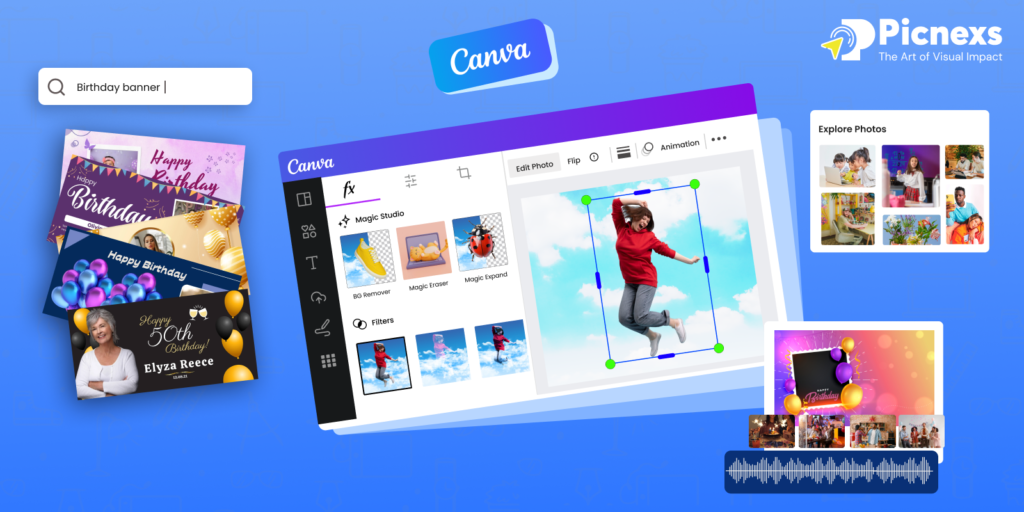
Overview: Canva is still the most user-friendly and feature-rich free graphic design tool. It has a drag-and-drop interface that allows even beginners to utilize it.
It is a great tool for quick and professional-looking designs with thousands of free templates, stock images, and design elements.
According to Statista, Canva has 55 million monthly active users around the globe, which signifies its popularity with more new users coming every day.
Pros:
- Drag-and-drop functionality
- Thousands of free templates for social media, presentations, and more
- Access to a free library of photos, icons, and fonts
- Basic video editing features
Cons:
- Limited advanced editing features compared to Photoshop
- The free version has restricted assets
- Cannot edit raster images in-depth
Best for: Beginners, social media creators, and marketers
Pricing: Free (with optional paid plans for extra features).
2) GIMP (GNU Image Manipulation Program)
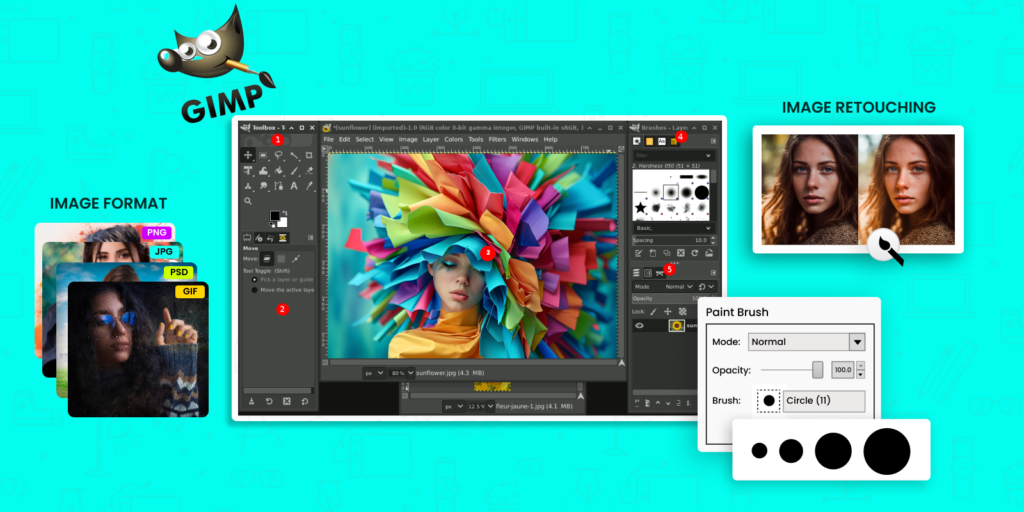
Overview: GIMP is an impressively functional alternative to Photoshop which has been developed as open source software.
It comes with tons of features true to high-end editing principles, but costs significantly less than its proprietary rival.
Pros:
- Advanced photo retouching tools
- Support for various file formats
- Customizable brushes and layers
- Plugin support for extended functionality
Cons:
- Steep learning curve for beginners
- The user interface can feel outdated
- No cloud storage or real-time collaboration
Best for: Professional photo editors and designers who want a free alternative to Photoshop
Pricing: Free.
3) Inkscape
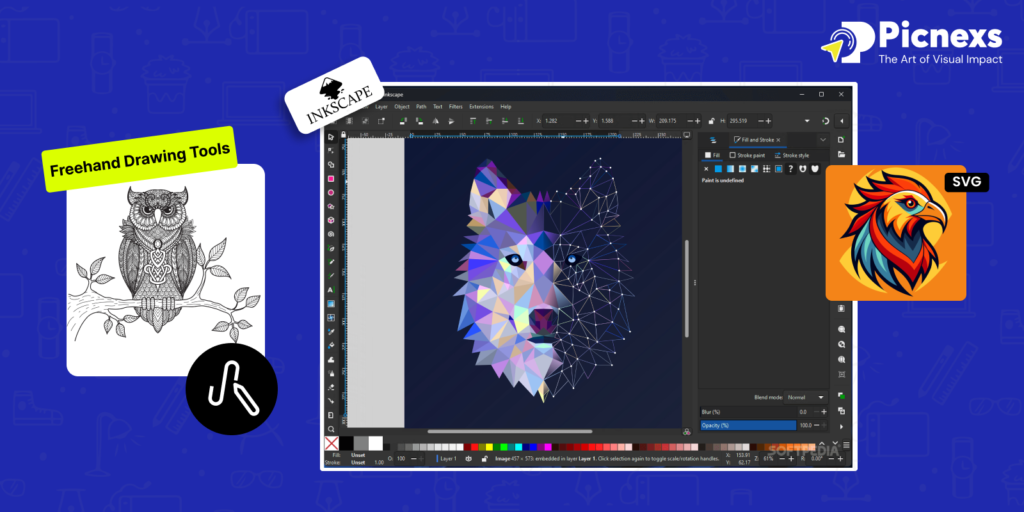
Overview: Inkscape is a vector graphic editor that is very suitable for creating illustrations, logos, and icons.
It provides very powerful design tools for free, which makes it a great choice for those who need scalable graphics but do not want to pay for software like Adobe Illustrator.
It is beyond the shadow of a doubt that Inkscape, according to SourceForge, has been installed over 9 million times, and it is by far one of the most popular free vector graphic design tools that are famous among people.
It is beyond the shadow of a doubt that Inkscape, according to SourceForge, has been installed over 9 million times, and it is by far one of the most popular free vector graphic design tools that are famous among people.
- Pricing: Free
- Pros:
- Free and open-source
- SVG file format support
- Advanced object manipulation
- Freehand drawing tools
- Free and open-source
- Cons:
- Performance can lag with complex projects
- UI feels less intuitive compared to paid tools
- Lacks some advanced typography features
- Performance can lag with complex projects
- Best for: Graphic designers and illustrators on a budget
4) Figma (Free Plan)
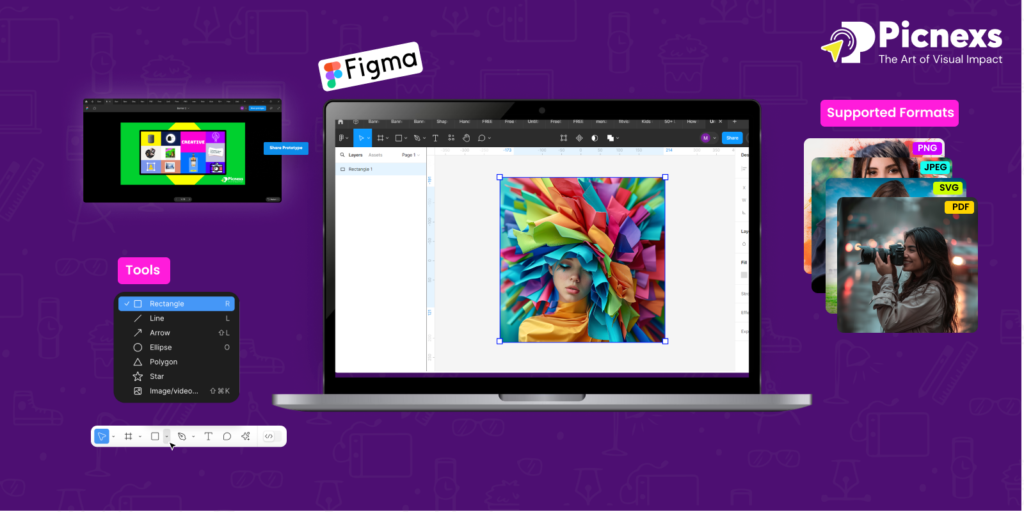
Overview: Figma is a web-based design application, which is perfect for UI/UX design.
It allows designers to work together in the place and make prototypes for the web and mobile applications.
Figma, which over 4 million people use actively every month, and is continuously expanding as more companies are adopting the use of collaborative design tools, is still the claim to fame of Figma.
Pricing: Free (with paid plans for more features)
- Pros:
- Cloud-based collaboration
- Prototyping tools
- Basic vector editing
- Available on all devices
- Cloud-based collaboration
- Cons:
- The free version has limited storage
- Advanced features are locked behind the Pro plan
- Requires an internet connection
- The free version has limited storage
- Best for: UI/UX designers working in teams
5) Photopea
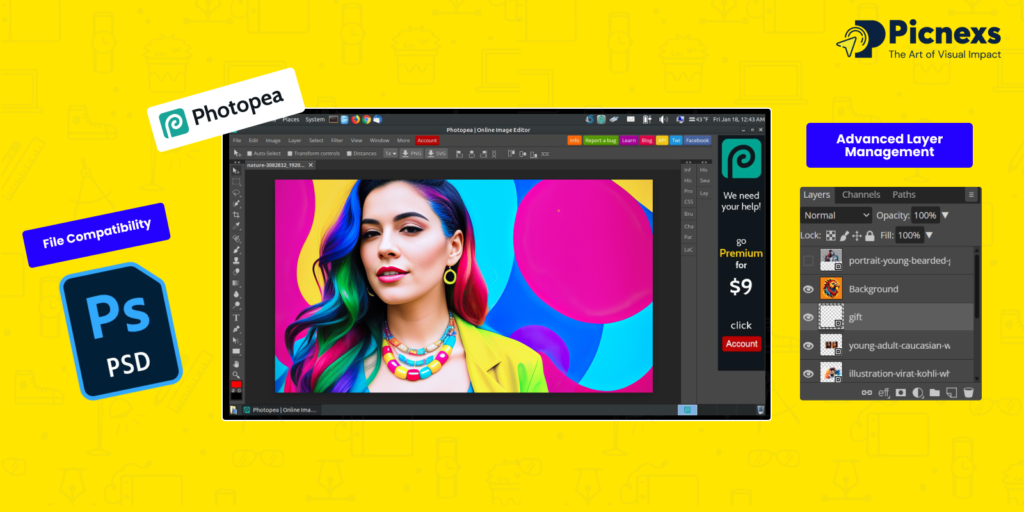
Overview: Photopea is a web-based Photoshop alternative application that can be run in the browser.
It comes with a wide range of tools, for example, Photoshop, for advanced layers and other features in the editor, but this is the best because no installation is required.
By this point in time, namely 2024, Photopea has been visited by over three million people in a month, which is clearly its popularity as a viable alternative.
- Pricing: Free (with ads) or $9/month (ad-free version)
- Pros:
- PSD file compatibility
- Advanced layer management
- No installation required
- Free to use
- PSD file compatibility
- Cons:
- Ads in the free version
- Lacks AI-powered features of Photoshop
- Performance issues with large files
- Ads in the free version
- Best for: Quick photo editing without software installation
6) Krita
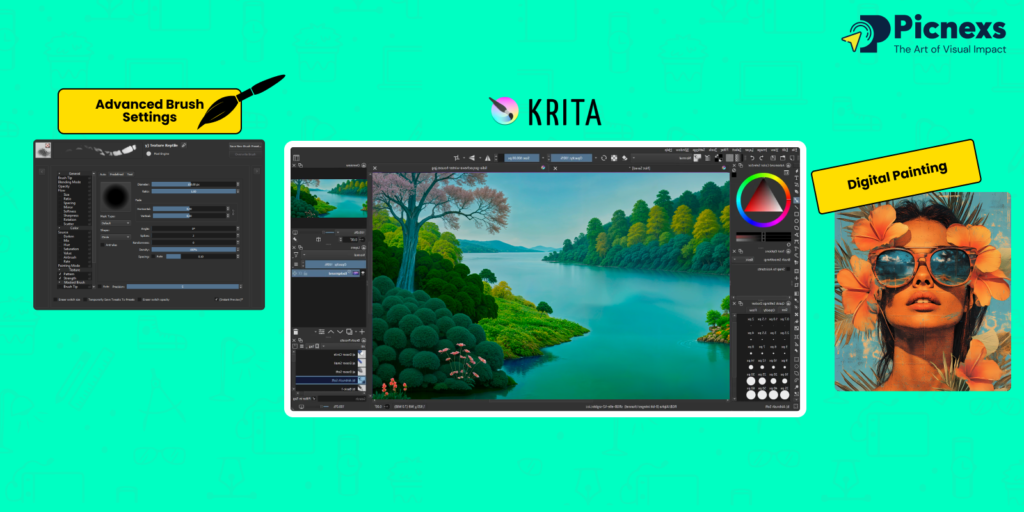
Overview: Krita is a free digital painting tool primarily designed for artists and illustrators.
Moreover, it has immensely powerful brush machines and customization options to produce extraordinary digital artwork.
Krita’s official website boasts it has exceeded 35 million downloads since the birth of its app, which is the best proof of its popularity in digital artistry.
- Pricing: Free
- Pros:
- Free and open-source
- Advanced brush settings
- Ideal for digital painting
- Free and open-source
- Cons:
- Not suitable for photo editing
- UI can be complex for beginners
- Not suitable for photo editing
- Best for: Digital artists and illustrators
Best Paid Graphic Design Tools
7) Adobe Photoshop
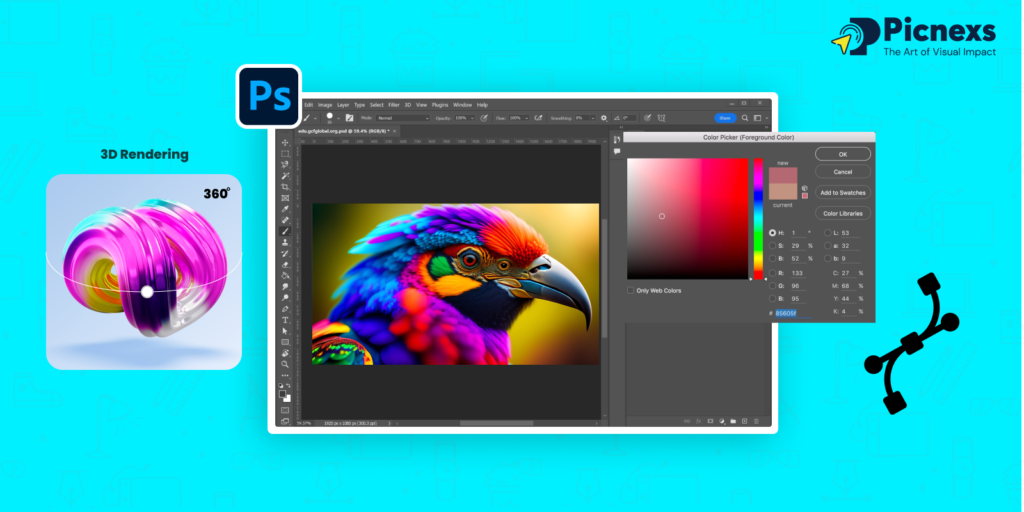
Overview: Adobe Photoshop is an undisputed industry leader in the field of photo editing and digital art creation.
Last year, in 2024, Adobe Photoshop was relishing in its glory with over 30 million subscribers globally, making it the most used photo editing software on earth.
Professionals commonly use such tools for image manipulation, retouching, and digital painting.
- Pricing: $20.99/month (Single App) or $54.99/month (Creative Cloud All Apps)
- Pros:
- Extensive tools for photo editing, retouching, and manipulation
- Supports advanced features like 3D rendering and video editing
- Seamless integration with other Adobe Creative Cloud apps
- Vast library of brushes, filters, and plugins
- Excellent support and tutorials from Adobe
- Extensive tools for photo editing, retouching, and manipulation
- Cons:
- Steep learning curve for beginners
- Subscription-based pricing can be expensive
- Can be resource-intensive, requiring powerful hardware
- Steep learning curve for beginners
- Best for: Professional photographers, designers, and illustrators looking for high-end design features
8) Adobe Illustrator
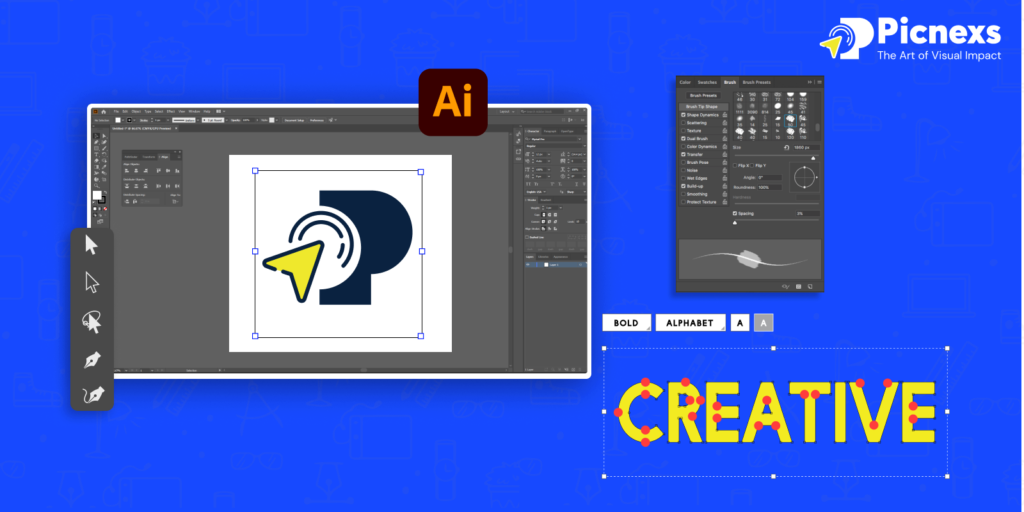
Overview: Adobe Illustrator is among the desired tools that produce logos, icons, and vector graphics.
Adobe Illustrator takes a 30% share of the global market of vector editing software, as per Statista.
It has cutting-edge features that enable the creation of great compositions like packaging artworks, banners, etc., while facilitating easy control over text and vector designs for professional graphics and web design.
- Pricing: $20.99/month (Single App) or $54.99/month (Creative Cloud All Apps)
- Pros:
- Ideal for creating scalable vector graphics like logos and illustrations
- Advanced typography tools for font manipulation and design
- Integration with other Adobe apps such as Photoshop and InDesign
- Extensive library of brushes and design assets
- Regular updates and a large user community
- Ideal for creating scalable vector graphics like logos and illustrations
- Cons:
- Steep learning curve for beginners
- Subscription-based pricing can be expensive
- May not be as efficient for detailed photo editing compared to Photoshop
- Requires powerful hardware to run smoothly
- Steep learning curve for beginners
- Best for: Professional graphic designers and illustrators focused on vector-based designs and scalable graphics
9) Affinity Designer
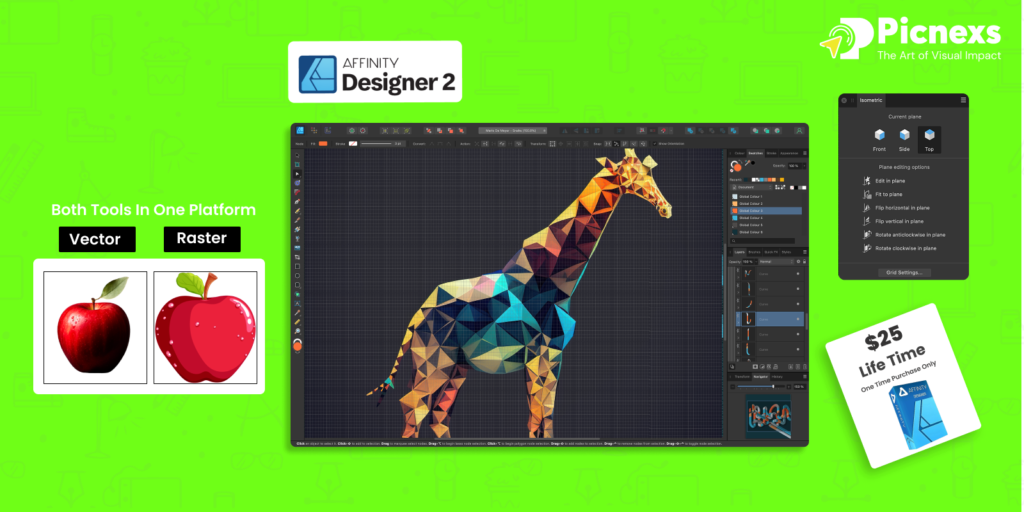
Overview: In terms of graphic design editors, Affinity Designer constitutes a complete toolbox containing both raster and vector design functions.
It is a perfect choice for those who want to try something different from Illustrator for a small budget, and need not say, it is highly performant as well as giving you access to many advanced tools.
Based on Affinity’s official site information, Affinity Designer has sold more than 1 million copies as of now, which is the reason behind the product’s wide acceptance by designers.
Pricing: $54.99 (One-time payment for Mac/Windows), $19.99 (iPad version, one-time payment).
Pros:
- One-time purchase fee, no subscription required
- Combines both vector and raster tools in one platform
- Smooth performance, even on lower-end systems
- Advanced grid and snapping tools for precise design
- Regular updates and affordable pricing
Cons:
- Lacks some advanced features and integrations that Illustrator offers
- Some tools may be more limited compared to Adobe software
- Slight learning curve for those transitioning from other design software
- No cloud storage or collaboration features (compared to cloud-based platforms)
Best for: Designers on a budget who need a powerful tool for both vector and raster design without the ongoing cost of Adobe subscriptions.
10) CorelDRAW
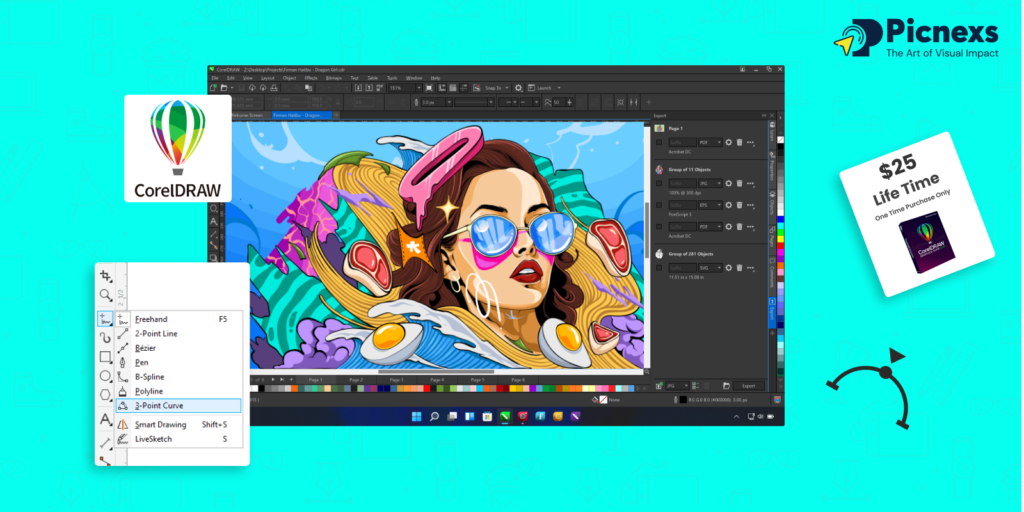
Overview: CorelDRAW is a reliable vector tool for graphics designers. It is an in-demand software among professionals specializing in logo design, typography, and print production.
During the recent year, CorelDRAW has reached the threshold of 10 million users worldwide, according to the Corel Corporation’s research, which is a sign of its acceptance among professionals from the vector design domain.
Pros:
- One-time purchase or subscription option
- AI-powered image enhancement tools
- Advanced typography features
- Excellent for vector-based design
Cons:
- Learning curve for beginners
- Fewer integrations compared to Adobe products
- Expensive compared to some alternatives
Pricing: Starts at $22.42/month or a one-time payment of $499
Best for: Professional designers, illustrators, and marketing teams
11) Sketch
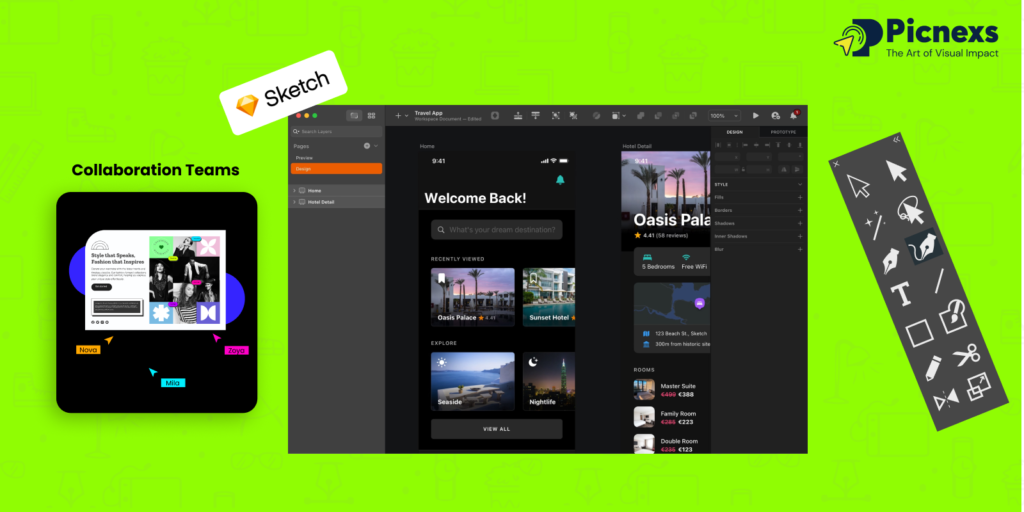
Overview: Sketch has received a reputation for its easy and intuitive approach to UI/UX design, most notably.
It demonstrates its ease of use through its simple design. It has the right level of simplicity to be the perfect go-to option for most designers.
It is one of the software products with the highest users. Sketch’s reports show that the program has 1 million users, among whom the majority are web and mobile designers.
Pros:
- Intuitive vector-based design tools
- Collaboration features for UI/UX teams
- Lightweight and optimized for macOS
- Extensive plugin ecosystem
Cons:
- Mac-only software
- Lacks advanced photo editing tools
- Requires additional plugins for extended functionality
Pricing: $9/month per editor
Best for: UI/UX designers working on macOS
12) Procreate
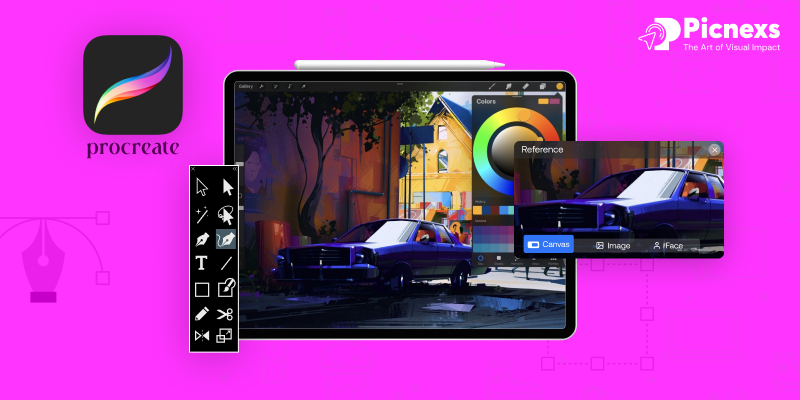
Overview: Exclusive painted-like brush strokes for the digital platform are the unique elements that Procreate uses to entice customers.
And not only is the app extremely successful in general, but it has also been downloaded more than 30 million times on the Apple App Store, serving as the most liked digital painting app so far.
Pros:
- One-time purchase, no subscription required
- Smooth and responsive brush engine
- High-resolution support for professional artwork
- Apple Pencil compatibility for precise drawing
Cons:
- iPad-only
- Lacks vector editing tools
- No cloud collaboration features
Pricing: One-time payment of $12.99
Best for: Digital painters, illustrators, and concept artists
13) Xara Designer Pro+
Overview: Xara Designer Pro+ is also a photo editing tool that is suitable for almost all business activities, such as vector graphics design and page layout design.
Being used by 2 million active users across the globe, Xara Designer Pro has provided an effective single tool solution for people who need a range of design features in one.
Pros:
- Combines vector and photo editing in one tool
- Fast performance and smooth workflow
- Supports multi-page layouts
- Affordable compared to Adobe alternatives
Cons:
- UI can feel outdated
- Lacks AI-powered features found in Adobe products
- Limited industry adoption compared to Illustrator or Photoshop
Pricing: Starts at $16.95/month
Best for: Designers who need a multi-functional tool for various design tasks
14) VistaCreate (Formerly Crello)
Overview: One of the competitors of Canva is VistaCreate. However, VistaCreate differs from Canva in that it is equipped with advanced animation features and video editing capabilities.
These characteristics of passing a message make it most suitable for marketers, small business owners, and content creators that require a first and efficient way of making designs.
VistaCreate is recognized by over 25 million users worldwide according to VistaCreate’s official blog.
Pros:
- Easy-to-use interface with drag-and-drop tools
- Thousands of customizable templates
- Advanced animation and motion design features
- Affordable compared to Adobe’s suite
Cons:
- Lacks professional-grade vector editing
- Limited customization options compared to Photoshop
- Cloud-based, requiring an internet connection
Pricing: Starts at $10/month
Best for: Marketers, social media managers, and small business owners
15) Gravit Designer Pro
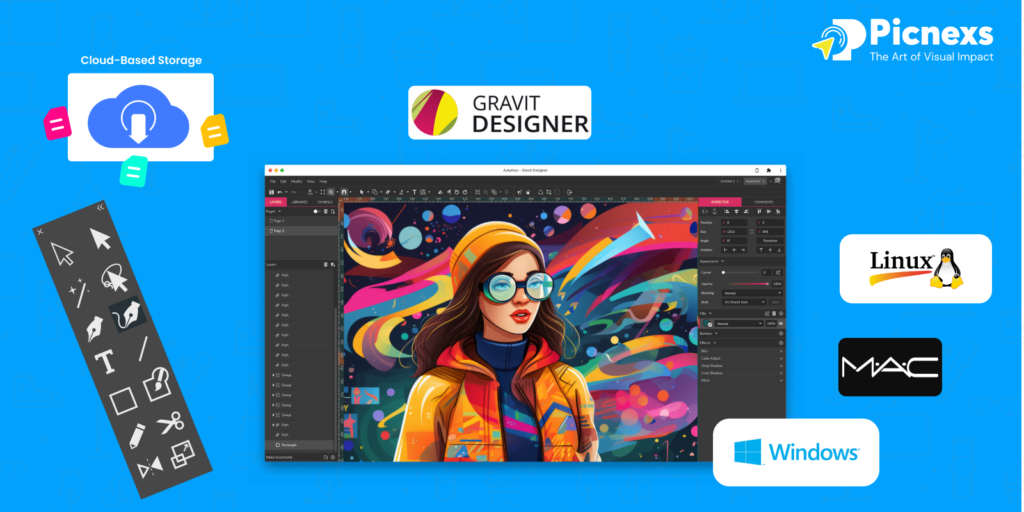
Overview: Gravit Designer Pro is a bunch of features that come from Adobe Illustrator and Figma and work with vector graphic design.
One of the major advantages of this software is its affordability when compared with other professional tools.
Gravit Designer has seen its use by 2 million users worldwide, as per the blog post published at Gravit’s official page.
The blog post talks of the growth in popularity of the software as a preferred tool for creating static and animated content.
Pros:
- Cross-platform support (Windows, Mac, Linux, and web)
- Cloud-based storage for easy access
- Advanced vector tools for precise design
- Affordable pricing
Cons:
- Limited free version
- Lacks raster editing features
- Some features require an internet connection
Pricing: Starts at $49.99/year
Best for: Designers looking for a budget-friendly vector tool
Which Graphic Design Tool is Best for You?
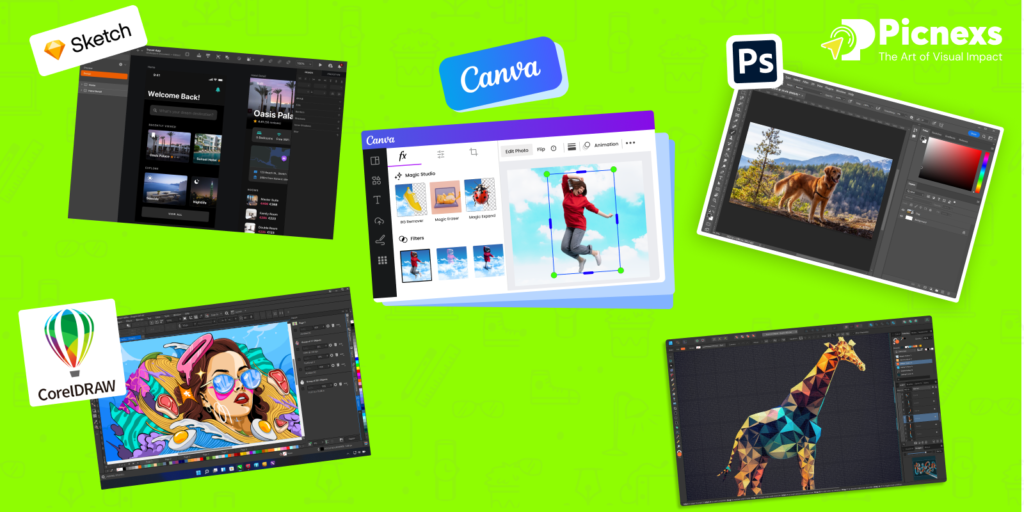
While choosing graphic design tools, keep the following factors in mind to select the most appropriate one for your specific conditions:
For Advanced Photo Editing & Digital Art:
If you are a professional photographer or digital artist, Adobe Photoshop is just the tool for you.
It is the best on the market for intricate photo manipulation, retouching, and the creation of high-quality digital artwork.
The variety of features presented makes it the perfect choice for complex, high-end design work.
For Vector-Based Designs & Illustrations:
If developing logos, icons, and scalable graphics is your primary goal, Adobe Illustrator is what a real graphic designer needs.
It is characterized by exceptional accuracy and control functions due to its robust features in typography, as well as the handling of complex vector graphics, which makes it the favorite tool for experts in the field of graphic design.
For Affordable Vector & Raster Design:
Affinity Designer is a good option for creating both vector and raster graphics if you don’t want a subscription.
The application’s speed of work and extended set of tools make it the first choice of choosing graphic design software on a low budget.
Your preferences with graphic design software are the main determinants of what you select, based on the strength of your bill, the complexity of the project you are working on, and if you prefer a subscription to a one-time purchase.
Conclusion
Deciding the right graphic design tools will be the crux of your success in the design appeasements of 2025.
Tools like Adobe Photoshop and Adobe Illustrator offer high-level functionality and are considered industry standards, although one has to pay for a subscription.
In contrast to these, Affinity Designer is not only a budget-friendly but also a robust platform to support your novel or altered raster and vector design.
Whether you are a professional designer or just starting out in the industry, there is definitely a graphic design software tool that fits your workflow.
Proceed with your specific needs in terms of design as well as your budget to decide the most pertinent kit for your project.
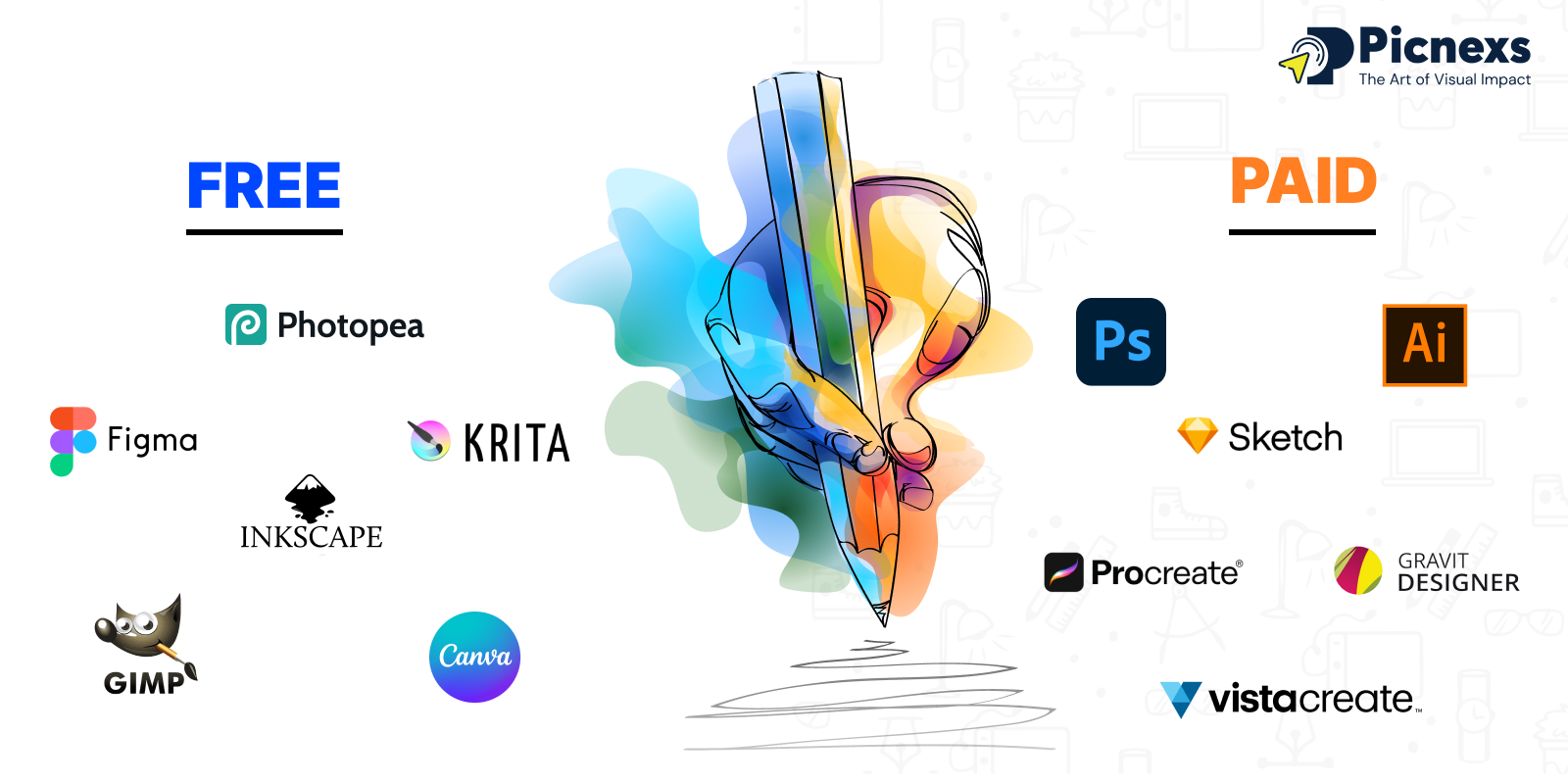
Leave a Reply